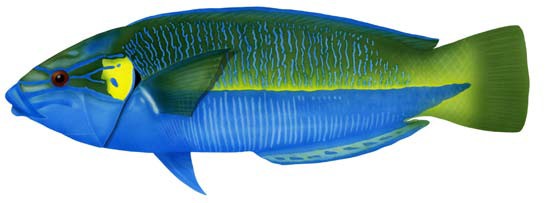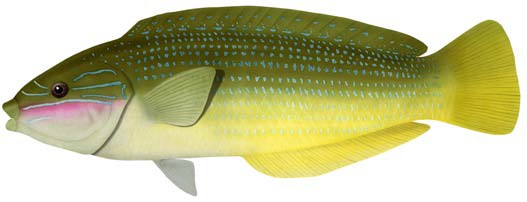
Elegant wrasse
Anampses elegans


Elegant wrasse are a widespread but uncommon species found on coral reef and rocky reef habitats at depths from 2 to 35 m. The distribution of elegant wrasse extends from southern Queensland to Montague Island on the NSW south coast, particularly around inshore islands. The species is also found at Lord Howe Island, especially in the shallow lagoon habitat, and at nearby Elizabeth and Middleton Reefs.
Elegant wrasse have also been recorded from Norfolk Island, the Kermadec Islands, New Zealand and other distant locations in the Pacific Ocean including Easter Island. Elegant wrasse are a subtropical, warm-temperate species that are active during the day.
Elegant wrasse are listed as a protected fish in NSW under the Fisheries Management Act 1994. Heavy penalties apply for taking or possessing them.
Description
Elegant wrasse grow to approximately 30 cm in length. They have several colour forms and their appearance is reported to vary with age and size. Juveniles are similar to adult females, gold to dusky brown with light blue spots; however, juveniles lack a pink band on their cheek.
Habitat and ecology
- Elegant wrasse can be found in different habitats depending on life cycle stage. Juveniles are found among seaweed in coastal bays and harbours. Juveniles travel in small schools feeding in short bouts.
- They are most common around inshore islands on the coast of NSW. Large juveniles are found in small aggregations on coastal rocky reefs.
- Adults occupy deeper habitats to over 30 m.
- They are carnivorous, feeding on small crustaceans and molluscs by scraping the surface of small seaweeds with their forward- projecting comb-like teeth.
- Little detailed information on the biology of the species is known; however, it is suspected that, like many other wrasse species, juvenile elegant wrasse are all female. Once mature, the dominant female changes sex to a male and will control a school of female fish.
- If the male disappears, the most dominant female, usually the largest, will change sex and take over the school. Males cannot change back to females and are referred to as ‘terminal males’.
- Terminal males are territorial and swim between groups of females.
- Protecting the habitats of elegant wrasse. Seaweed beds in coastal bays and harbours are important for juveniles, while coral and rocky reef habitats appear to be important for sub-adults and adults.
- Elegant wrasse habitat is located in a number of protected areas in NSW, including Port Stephens – Great Lakes Marine Park, Solitary Islands Marine Park, Julian Rocks Aquatic Reserve, Middleton and Elizabeth Reefs Marine National Nature Reserve and Lord Howe Island Marine Park.
- Maintaining bans on taking elegant wrasse in NSW and protecting them from illegal removal.
- Educating fishers on the best ways to return any incidentally caught elegant wrasse to the water.
Why are elegant wrasse protected?
Elegant wrasse are protected due to their natural rarity and low abundance. The species is unlikely to be able to sustain fishing pressure.
What conservation actions are underway?
Legal implications
Taking or possessing elegant wrasse (or any other species of protected fish) is an offence and heavy penalties apply. For corporations these penalties can include fines of up to $55 000 while individuals can face fines of up to $11 000 and up to 3 months in prison.
Bibliography and further reading
Ayling T 1982, Collins guide to the sea fishes of New Zealand, Collins, Auckland, New Zealand.
Coleman N 1981, Australian sea fishes north of 30 degrees south, Doubleday, Lane Cove, NSW, Australia, 297 pp.
Gill AC & Reader SE 1992, ‘Fishes’, in: ‘Reef biology. A survey of Elizabeth and Middleton Reefs, South Pacific, by the Australian Museum’,
Kowari 3: 90–2, ANPWS, Canberra.
Hutchins B & Swainston R 1986, Sea fishes of southern Australia. Complete field guide for anglers and divers, Swainston Publishers, Perth, WA, Australia, 180 pp.
Kuiter RH 1993, The complete divers and fishermans guide to coastal fishes of south- eastern Australia, Crawford House Press, Bathurst, NSW, Australia, 290 pp.
Lieske E & Myers R 1994, Coral reef fishes. Caribbean, Indian Ocean and Pacific Ocean including the Red Sea, Harper Collins, Sydney, 400 pp.
Ogilby JD 1889, ‘The reptiles and fishes of Lord Howe Island’, in: ‘Lord Howe Island, its zoology, geology and physical characteristics’, Memoirs of the Australian Museum No. 2 (3): 49–74.
Parker PG 1999, ‘Fish assemblages at Julian Rocks and the adjacent waters of northern New South Wales, Australia’, Australian Zoologist 31(1): 134–60.
Randall JE 1974, Notes and color illustrations of labrid fishes of the genus Anampses, reprinted from UO 21: 10–16, Bishop Museum, Honolulu
For further information
For more information on general fishing regulations check with your local fisheries office or visit www.dpi.nsw.gov.au/fisheries
To contact your local NSW Fisheries Office visit https://www.dpi.nsw.gov.au/contact-us/contact-a-dpi-fisheries-officer or phone 1300 550 474.

